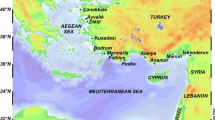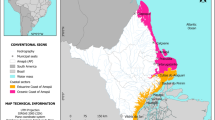Abstract
In this study, the seasonal and annual changes of key environmental parameters in the Sea of Oman during the period 2005–2012 have been investigated using a range of Earth Observation datasets. Furthermore, the seasonal and spatial variability of those changes to other environmental parameters for the same time period was also explored. Analysis of census of the anti-cyclonic and cyclonic eddies using the Okubo–Waiss algorithm was carried out in a Geographical Information Systems environment using the Marine Geospatial Ecology Tools. Results indicated that the Sea of Oman is mostly influenced by seasonality and by location. The Spearman’s rank correlation test shows a strong, negative correlation between Sea Surface Temperature (SST) and Chlorophyll-a (Chlor-a) in most parts of the sea during the studied period. In terms of spatial variations, eastern parts of the sea showed higher Chlor-a concentrations and lower SST values, especially during summer. The Okubo–Waiss algorithm revealed the existence of 337 eddies, 180 of which are anti-cyclonic eddies with general life span ranging from 4 to 43 weeks, while years 2008 and 2010 presented the most cyclonic eddies. The presence and duration of these eddies proved to be a great contributor in water mixing in the region. Our results clearly demonstrated that this integrated approach improved our understanding of the sea-atmosphere dynamics and environmental variability of the studied region.

Source: http://www.eoearth.org, from Rosenstiel School of Marine and Atmospheric Science, University of Miami. Accessed 15/7/2019













Similar content being viewed by others
References
Al-Gheilani, H. M., Matsuoka, K., Al-Kindi, A. Y., Amer, S., & Waring, C. (2011). Fish kill incidents and harmful algal blooms in Omani waters. Journal of Agriculture and Marine Science, 16, 1–11.
Behrenfeld, M. J., O’Malley, R. T., Siegel, D. A., McClain, C. R., Sarmiento, J. L., Feldman, G. C., et al. (2006). Climate-driven trends in contemporary ocean productivity. Nature, 444(7120), 752–755.
Belkin, I. M., & O’Reilly, J. E. (2009). An algorithm for oceanic front detection in chlorophyll and SST satellite imagery. Journal of Marine Systems, 78(3), 319–326.
Bennett, N. (2018). Navigating a just and inclusive path towards sustainable oceans. Marine Policy, 97, 139–146.
Bierman, P., Lewis, M., Ostendorf, B., & Tanner, J. (2011). A review of methods for analysing spatial and temporal patterns in coastal water quality. Ecological Indicators, 11(1), 103–114.
Böhm, E., Morrison, J. M., Manghnani, V., Kim, H. S., & Flagg, C. N. (1999). The Ras al Hadd Jet: remotely sensed and acoustic Doppler current profiler observations in 1994–1995. Deep Sea Research Part II: Topical Studies in Oceanography, 46(8–9), 1531–1549.
Bouffard, J., Naeije, M., Banks, C. J., Calafat, F. M., Cipollini, P., Snaith, H. M., et al. (2018). CryoSat ocean product quality status and future evolution. Advances in Space Research, 62(6), 1549–1563.
Brown, O. B., & Minnet, P. J. (1999). MODIS infrared sea surface temperature algorithm. Algorithm Theoretical Basis Document, University of Miami.
Byju, P., & Prasanna, K. S. (2011). Physical and biological response of the Arabian Sea to tropical cyclone Phyan and its implications. Marine Environmental Research, 71(5), 325–330.
Cayula, J. F., & Cornillon, P. (1992). Edge detection algorithm for SST images. Journal of Atmospheric and Oceanic Technology, 9(1), 67–80.
Chi, L., Wolfe, C. L. P., & Hameed, S. (2018). Intercomparison of the Gult Stream in ocean reanalyses: 1993–2010. Ocean Modelling, 125, 1–21.
Chin, T. M., Vazquez-Cuervo, J., & Armstrong, E. M. (2017). A multi-scale high resolution analysis of global sea surface temperature. Remote Sensing of Environment, 200, 154–169.
Cooper, H., Chen, Q., Fletcher, C., & Barbee, M. (2013). Assessing vulnerability due to sea level rise in Maui, Hawaii using LiDAR remote sensing and GIS. Climatic Change, 116(3–4), 547–563.
Dassenakis, M., Paraskevopoulou, V., Cartalis, C., Adaktilou, N., & Katsiabani, K. (2011). Remote sensing in coastal water monitoring: Applications in the eastern Mediterranean Sea (IUPAC Technical Report). Pure and Applied Chemistry, 1, 335–375.
Fernández-Prieto, D., Kesselmeier, J., Ellis, M., Marconcini, M., Reissell, A., Suni, T., et al. (2013). Earth observation for land–atmosphere interaction science. Biogeosciences, 10, 261–266.
Harrison, C. S., & Glatzmaier, G. A. (2010). Lagrangian coherent structures in the California Current System: sensitivities and limitations. Geophysical and Astrophysical Fluid Dynamics, 106(1), 22–44.
He, X., Pan, D., Bai, Y., Wang, T., Chen, C.-T. A., Zhu, Q., et al. (2017). Recent changes of global ocean transparency observed by SeaWiFS. Continental Shelf Research, 143, 159–166.
Henson, S. A., & Thomas, A. C. (2007). A census of oceanic anticyclonic eddies in the Gulf of Alaska. Deep Sea Research I, 55, 163–176.
Henson, S. A., & Thomas, A. C. (2008). A census of oceanic anticyclonic eddies in the Gulf of Alaska. Deep Sea Research Part I: Oceanographic Research Papers, 55(2), 163–176.
Ji, C., Zhang, Y., Cheng, Q., Li, Y., Jiang, T., & Liang, X. S. (2018a). Pn the relationship between the early spring Indian Ocean’s sea surface temperature (SST) and the Tibetan Plateau atmospheric heat source in summer. Global and Planetary Change, 164, 1–10.
Ji, C., Zhang, Y., Cheng, Q., Tsou, J., Jiang, T., & Liang, X. S. (2018b). Evaluating the impact of sea surface temperature (SST) on spatial distribution of chlorophyll-a concentration in the East China Sea. International Journal of Applied Earth Observation & Geoinformation, 68, 252–261.
Kaufman, Y. J., Herring, D. D., Ranson, K. J., & Collatz, G. J. (1998). Earth Observing system AM1 mission to earth. Geoscience and Remote Sensing, IEEE Transactions on, 36(4), 1045–1055.
L’Hégaret, P., Lacour, L., Carton, X., Roullet, G., Baraille, R., & Corréard, S. (2013). A seasonal dipolar eddy near Ras Al Hamra (Sea of Oman). Ocean Dynamics, 63(6), 633–659.
Markogianni, V., Kalivas, D., Petropoulos, G. P. & Dimitriou, E. (2018). An appraisal of the potential of landsat 8 in estimating Chlorophyll-a, Ammonium Concentrations and Other Water Quality Indicators. Remote Sensing, 10(7), 1018.
Markogianni, V., Kalivas, D., Petropoulos, G. P. & Dimitriou, E. (2020) Estimating chlorophyll-a of inland water bodies in Greece based on landsat data. Remote Sensing, 12(13), 2087
Martin, S. (2004). An introduction to ocean remote sensing. Cambridge: Cambridge University Press.
McGillicuddy, D. J., et al. (2007). Eddy/wind interactions stimulate extraordinary midocean plankton blooms. Science, 316(5827), 1021–1026.
Meehl, G. A., Stocker, T. F., Collins, W. D., Friedlingstein, P., Gaye, A. T., Gregory, J. M., et al. (2007). Global climate projections. In S. Solomon, D. Qin, M. Manning, Z. Chen, M. Marquis, K.B. Averyt, et al. (Eds.), Climate change 2007: The physical science basis. Contribution of working group I to the fourth assessment report of the intergovernmental panel on climate change. United Kingdom and New York, USA: Cambridge University Press.
Miller, P. (2004). Multi-spectral front maps for automatic detection of ocean colour features from SeaWiFS. International Journal of Remote Sensing, 25(7–8), 1437–1442.
Mudgal, R., & Pandey, M. K. D. P. (2009). Seasonal and inter-annual variability of Chlorophyll–a in the Arabian sea from SeaWiFS data. Earth Science India, 2(1), 21–32.
Nandkeolyar, N., Raman, M., Kiran, G. S., & Ajai, (2013). Comparative analysis of sea surface temperature pattern in the eastern and western gulfs of arabian sea and the red sea in recent past using satellite data. International Journal of Oceanography, 2013, 16.
O’Reilly, J. E., Maritorena, S., Siegel, D. A., O’Brien, M. C., Toole, D., Mitchell, B. G., et al. (2000). Ocean color chlorophyll a algorithms for SeaWiFS, OC2, and OC4: Version 4. SeaWiFS Post Launch Calibration and Validation Analyses, 3, 9–23.
Palacios, D. M., Bograd, S. J., Foley, D. G., & Schwing, F. B. (2006). Oceanographic characteristics of biological hot spots in the North Pacific: A remote sensing perspective. Deep-Sea Research Part Ii-Topical Studies in Oceanography, 53(3–4), 250–269.
Petihakis, G., Triantafyllou, G., Korres, G., Tsiaras, K., & Theodorou, A. (2012). Ecosystem modelling: Towards the development of a management tool for a marine coastal system part-II, ecosystem processes and biogeochemical fluxes. Journal of Marine Systems, 94, S49–S64.
Piontkovski, S. A., & Nezlin, N. P. (2012). Mesoscale eddies of the Arabian Sea: Physical–biological interactions. International Journal of Marine Science, 2, 51–56.
Quinn, N., & Johnson, D. (1996). Cold water upwellings cover Gulf of Oman coral reefs. Coral Reefs-Journal of the International Society for Reef Studies, 15(4), 214.
Resplandy, L., Lévy, M., Madec, G., Pous, S., Aumont, O., & Kumar, D. (2011). Contribution of mesoscale processes to nutrient budgets in the Arabian Sea. Journal of Geophysical Research, 116(C11), C11007.
Sarma, Y. V. B., Al-Hashmi, K., & Smith, S. L. (2013). Sea surface warming and its implications for harmful algal blooms off Oman. International Journal of Marine Science, 3(8), 65–71. https://doi.org/10.5376/ijms.2013.03.0008.
Wang, Z., DiMarco, S. F., Jochens, A. E., & Ingle, S. (2013). High salinity events in the northern Arabian Sea and Sea of Oman. Deep Sea Research Part I: Oceanographic Research Papers, 74, 14–24.
Xiu, P., Chai, F., Shi, L., Xue, H., & Chao, Y. (2010). A census of eddy activities in the South China Sea during 1993–2007. Journal of Geophysical Research, 115, C03012. https://doi.org/10.1029/2009JC005657.
Acknowledgements
Authors wish to thank the reviewers for their feedback that resulted to improving the submitted manuscript.
Author information
Authors and Affiliations
Corresponding author
Additional information
Publisher's Note
Springer Nature remains neutral with regard to jurisdictional claims in published maps and institutional affiliations.
Rights and permissions
About this article
Cite this article
Al-Hajri, S.M., Petropoulos, G.P. & Markogianni, V. Seasonal variation of key environmental parameters in the Sea of Oman using EO data and GIS. Environ Dev Sustain 23, 6021–6046 (2021). https://doi.org/10.1007/s10668-020-00860-5
Received:
Accepted:
Published:
Issue Date:
DOI: https://doi.org/10.1007/s10668-020-00860-5




